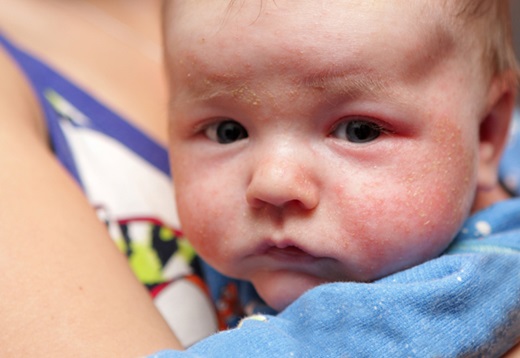Managing Eczema in Winter and Year Round: A Parents Guide
Cold, dry outdoor air and indoor heating can rob skin of its natural moisture in the winter. Red, crusty, dry patches can be common on a baby's skin, particularly in winter, and cause concern for parents. Such symptoms can be treated, however, and many babies and children do outgrow the dry, itchy skin of atopic dermatitis, also known as eczema.
We spoke with pediatric dermatologist Katherine Puttgen to learn more.

What is eczema?
Broadly speaking, eczema describes dry, rashy and itchy skin. It is a hereditary and chronic skin disorder most commonly seen in infants or very young children, often beginning in the first year of life and most commonly seen before age 5. Eczema is not contagious.
While many children outgrow eczema, for some it might last into adolescence or adulthood. The American Academy of Dermatology estimates that 10-to-20 percent of children in the world have eczema, and it affects up to 20 percent of infants.
What causes eczema in infants and children?
Eczema is brought about by the complex interplay of a genetic predisposition and the child’s environment. Many things – from the climate to possible allergens – can cause eczema to flare. We know that eczema tends to run in the families with a predisposition to other atopic diseases, such as food allergies, asthma and hay fever. Individuals with atopic dermatitis may lack certain proteins in the skin, which leads to greater sensitivity. Parents with eczema are more likely to have children with eczema. However, the exact way it passes from parents to children is still not known. Most children who have eczema will show signs of the condition in the first year of life. It tends to wax and wane in severity.
What causes eczema to wax, to flare?
Different "triggers" can make eczema worse. For infants, these can be irritants such as wool, certain detergents or extreme temperatures, or other immune triggers, such as food allergies and asthma, and even pet dander.
Most kids with the condition have the hardest time in winter, when the air is cold and dry. A small percentage has a harder time in the summer, when it is hot and humid.
What does it look like?
The signs of eczema in infants include itchy, dry and scaly skin, redness and swelling of the skin and small bumps that open and weep when scratched. In infants and young children, eczema is usually found on the face, outside of the elbows, and on the knees.
In older children and adults, eczema tends to be on the hands and feet, the arms, and on the back of the knees.Keep in mind that all patches of dry skin are not eczema. The cold, dry outdoor air and indoor heating can dry all babies’ skin in winter, causing dry patches. In children prone to dry skin, so can the sun, air conditioning, and pool and salt water.
We dermatologists usually say “if it’s not itchy, it’s not eczema”; you can’t make a diagnosis of eczema unless there is an itchiness that goes with the rash. Babies with cradle cap, also known as seborrheic dermatitis, can also have a wide-spread rash, which is not eczema in itself. But it is common for cradle cap and eczema to co-exist in the first several months of life.
How is eczema diagnosed?
Eczema symptoms may resemble other skin conditions, so always consult your child’s pediatrician. A diagnosis includes a complete medical history and a physical examination.
How is it treated?
Because there is not yet a cure for eczema, our treatment goals are to reduce itching and skin inflammation, and to prevent infection. The best treatment for eczema is a proactive one, using gentle skin care and moisturizers to re-establish the skin barrier.
Infants’ and older children’s skin should be kept well moisturized, and washed with fragrance-free non-soap cleansers. We also recommend a fragrance-free ointment-based moisturizer, with petrolatum as either the only or the first ingredient. In young children and infants, it is reasonable to use an over-the-counter topical hydrocortisone ointment, which is a mild topical steroid, for up to a week.
But if the rash either persists or you find that you need to use the hydrocortisone more than one week out of the month, you should discuss further use with your child’s pediatrician. You can apply the ointment, as prescribed, then a coat of petrolatum-based moisturizer, to help keep in the moisture.
For school-age children, who don’t want to be so greasy, we usually talk about creams. As for infants, though, when their skin gets very dry, we still recommend a petroleum-based ointment as a top coat. In addition to providing the best barrier protection, ointments don’t sting or burn when applied; creams and lotions sometimes can when the skin is inflamed and very dry. Moisturizers should be applied at least two to three times a day; for children in diapers, each diaper change can present an easy opportunity to moisturize the skin. More frequent use of moisturizers results in better control of itching and less frequent need for topical steroids, and it helps to restore the skin’s natural barrier function.
For all ages of kids with eczema, or prone to eczema, baths should be brief (less than 15 minutes) in warm water, to avoid over-drying of the skin. Children should be protected against scratching their skin (little mitts can help infants) and from irritants that contact their skin, such as harsh detergents and certain fabrics (including bedding). To reduce potential skin irritation, babies and children with eczema should wear only cotton or other natural fiber clothing next to the skin, with the exception of wool, of course. And they should be protected against cold (or very hot) environments to help prevent a skin reaction.
If your child’s skin does not respond well to any of these measures or becomes infected, contact your pediatrician, who can diagnose the condition and then prescribe another topical cream or antihistamine.
Is a cure or better treatment for eczema on the horizon?
Without a cure on the near horizon, we here at Johns Hopkins are creating an Eczema Day Treatment Unit to help our patients with moderate to severe eczema keep their symptoms under control and prevent flare-ups. We anticipate that this novel, multidisciplinary program will include experts from Child Life, behavioral psychology, allergy, dermatology and infectious diseases to provide the comprehensive care these children need – care that cannot be provided in an average clinic visit.
A primary goal of the day treatment unit will be education; children and their families will learn techniques such as wet-wrap therapy, to help deeply moisturize the skin. This therapy involves coating the skin with a topical ointment, followed by a greasy ointment like petroleum jelly, then dressing in wet pajamas, followed by dry pajamas, allowing the skin to soak in the moisture.
In partnering with our colleagues in behavioral psychology, we have seen many of our patients with severe eczema improve significantly with help in finding ways to avoid scratching, which inflames their skin condition, and by helping older children talk about the social difficulties in coping with a chronic condition or going to school with a visible disorder. Child Life specialists are an integral part of the Johns Hopkins Children’s Center and their ability to engage children in age-appropriate play and conversation is an important cornerstone of building a successful program. Because food and environmental allergies and skin infections are more frequent in children with moderate to severe eczema, strong partnerships with our experts in pediatric allergy and infectious diseases are key, as well.
What about research?
At Johns Hopkins, a lot of us in pediatric dermatology, pediatric infectious disease and pediatric allergy and immunology are looking at better ways to prevent or manage eczema. We’re studying the optimal management of bacterial colonization and infection in atopic skin and the role of food allergy in eczema. Our specialties collaborate; each brings a different approach to eczema management. Our goal is to work together to harness the best approaches to better understand eczema and, in doing so, to treat it more effectively.
What else is happening at Johns Hopkins today?
We go out of our way to provide the comprehensive care our patients with eczema need. On a case-by-case basis, we communicate with one another – whether in allergy, dermatology, psychology or infectious disease – to put together the best course of treatment for each child.We are optimistic that future therapies and approaches to care for those with even severe eczema are going to be greatly improved with more research and that the creation of the Eczema Day Treatment Unit will help us conduct cutting edge research and answer questions we face every day seeing and treating patients.
Like other atopic diseases, such as food allergies, is the incident of eczema in children increasing?
Yes. We don’t really know why. But we’re on the case to find answers.



